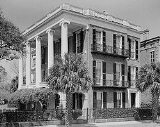
Robert William Roper House
Encyclopedia
Robert William Roper House was built about 1838 in Charleston, South Carolina
on land purchased by Robert W. Roper in May 1838. The authors of the nomination form for the National Register of Historic Places (1973) speculated that Edward B. White
was the architect, although no evidence is given in support of this. Others have suggested Charles F. Reichardt as the architect, but Reichardt worked exclusively in the Greek, rather than Roman, vocabulary.
It was declared a National Historic Landmark
in 1973.
The South Carolina Department of Archives and History summary is located here.
Charleston, South Carolina
Charleston is the second largest city in the U.S. state of South Carolina. It was made the county seat of Charleston County in 1901 when Charleston County was founded. The city's original name was Charles Towne in 1670, and it moved to its present location from a location on the west bank of the...
on land purchased by Robert W. Roper in May 1838. The authors of the nomination form for the National Register of Historic Places (1973) speculated that Edward B. White
Edward Brickell White
Edward Brickell White , also known as E. B. White, was an American architect. He was known for his Gothic Revival architecture and his use of Roman and Greek designs.-Life:...
was the architect, although no evidence is given in support of this. Others have suggested Charles F. Reichardt as the architect, but Reichardt worked exclusively in the Greek, rather than Roman, vocabulary.
It was declared a National Historic Landmark
National Historic Landmark
A National Historic Landmark is a building, site, structure, object, or district, that is officially recognized by the United States government for its historical significance...
in 1973.
The South Carolina Department of Archives and History summary is located here.
External links
- Roper House - Classical American Homes Preservation Trust, tour information
- Robert William Roper House, Charleston County (9 E. Battery, Charleston), at South Carolina Department of Archives and History

